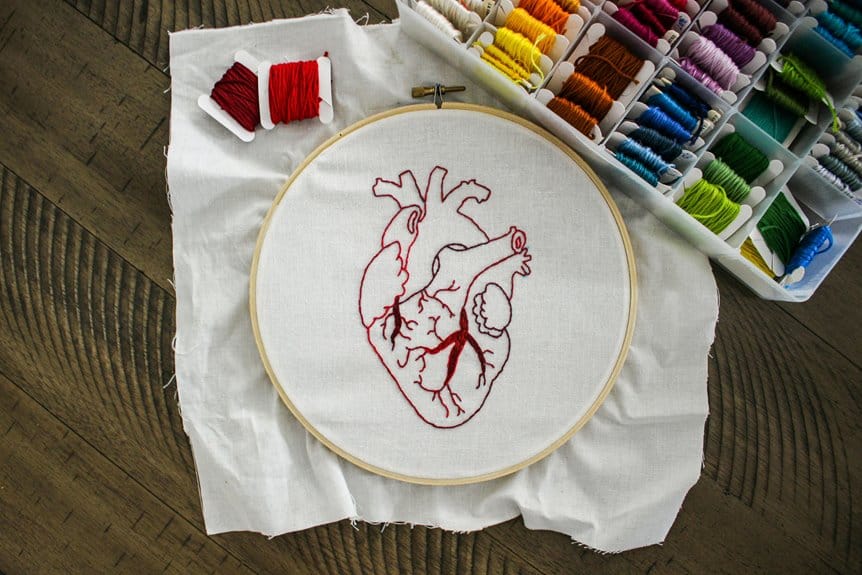Sustainable embroidery patches utilize organic cotton and hemp linen as base fabrics, reducing harmful pesticides in production. Plant-based threads derived from organic cotton, bamboo, and hemp offer eco-friendly alternatives to conventional options. Natural dyes from plants and minerals minimize environmental impact, while upcycled materials like denim scraps provide durable backing. Biodegradable stabilizers and zero-waste cutting techniques further reduce environmental footprints. Local artisan partnerships guarantee ethical sourcing and preserve traditional craftsmanship. These thoughtful material choices transform a simple craft into an environmentally responsible practice.
Organic Base Fabrics for Eco-Friendly Patches
The foundation of any eco-friendly embroidery patch begins with selecting the right organic base fabric. When crafters choose certified organic cotton, they guarantee their projects are free from harmful pesticides and chemicals that damage both ecosystems and worker health.
This material provides a smooth, stable surface that accepts needle and thread with minimal resistance, making it ideal for detailed embroidery work.
Hemp linen represents another sustainable alternative, requiring considerably less water than conventional fabrics and naturally resisting pests without chemical treatments.
Its distinctive texture adds character to finished patches while offering exceptional durability. The slightly coarser weave of hemp linen creates a rustic aesthetic that works particularly well for nature-inspired designs, though it may require stronger needles for proper stitching.
Plant-Based and Regenerative Embroidery Threads
While traditional embroidery threads often contain synthetic materials and chemical dyes, plant-based alternatives offer sustainable options that reduce environmental impact without sacrificing quality or appearance.
These threads derive from plant fibers such as organic cotton, hemp, linen, and bamboo, which require fewer resources to grow and process.
Regenerative agriculture practices enhance the sustainability of these threads by improving soil health and carbon sequestration.
Companies focusing on sustainable sourcing often work directly with farmers who avoid pesticides and implement crop rotation.
The eco-friendly production of these threads typically involves natural or low-impact dyeing processes, water conservation measures, and reduced energy consumption.
These methods eliminate the petroleum-based materials and toxic chemicals found in conventional threads, creating a healthier product for both artisans and the environment.
Natural Dyes and Low-Impact Coloring Methods
Natural dyes derived from plant materials, minerals, and even insects represent a fundamental shift away from synthetic coloring agents that dominate commercial embroidery supplies. These eco-friendly pigments offer embroiderers a way to reduce environmental impact while connecting to traditional textile practices. Plant-based dye sources include indigo, madder root, and marigold flowers, which produce vibrant yet biodegradable colors.
| Dye Source | Color Range | Mordant Required |
|---|---|---|
| Avocado pits | Pink to rust | No |
| Onion skins | Yellow to brown | Yes |
| Logwood | Purple to black | Yes |
When using natural plant based dyes, practitioners should consider both water usage and mordanting methods. Alum, the most common mordant, helps fix color to fibers but must be disposed of properly. Low-impact commercial dyes offer an alternative, using less water and energy while minimizing harmful chemical runoff.
Upcycled and Reclaimed Materials for Patch Backing
Resourceful embroiderers often turn to discarded denim, particularly from worn jeans and garment production scraps, as sturdy backing material that offers both durability and environmental benefits.
Upholstery fabric remnants from furniture manufacturing represent another untapped resource, with their robust weaves and interesting textures providing excellent stability for embroidered patches.
These reclaimed materials not only reduce textile waste in landfills but also encourage creative repurposing within the craft community, allowing artists to create patches with authentic character and reduced ecological impact.
Denim Remnant Champions
Discarded denim provides one of the most durable and versatile materials for patch backing in sustainable embroidery practices. The tight weave and natural thickness of denim remnants create an excellent foundation that withstands repeated washings and daily wear.
Denim recycling operations often discard smaller pieces that are perfect for embroidery applications, keeping these textiles out of landfills while providing crafters with high-quality backing materials.
When selecting denim scraps, crafters should look for medium-weight varieties that offer superior patch durability without being too difficult to stitch through. Pre-washed denim is particularly valuable as it has already completed its initial shrinkage cycle.
The natural cotton fibers accept dyes readily, allowing embroiderers to customize the backing color if the original blue doesn’t suit their design concept. This resourceful approach transforms manufacturing waste into functional art.
Furniture Fabric Treasures
Upholstery remnants from furniture manufacturing represent an untapped resource for patch embroidery backing materials. These durable fabrics, originally designed for years of use on sofas and chairs, provide exceptional stability for embroidery projects.
Furniture fabric patterns often feature subtle textures and weaves that complement hand-stitched designs without overwhelming them. When seeking eco-friendly upholstery scraps, crafters should investigate local furniture makers who may discard usable remnants during production.
- Velvet remnants offer rich texture and depth for sophisticated patch designs
- Microfiber scraps provide stain-resistant properties ideal for wearable patches
- Jacquard upholstery pieces add subtle pattern without affecting embroidery visibility
- Heavy cotton-blend furniture fabrics create sturdy foundations for larger patches
Repurposing these materials diverts textiles from landfills while providing embroidery artists with high-quality backing options that retail establishments rarely stock.
Biodegradable Stabilizers and Sustainable Interfacings
While traditional stabilizers and interfacings often contain synthetic materials that can take centuries to break down, the modern embroidery industry has developed impressive alternatives that minimize environmental impact.
The market now offers numerous biodegradable options made from water-soluble polymers, starches, and plant cellulose that provide adequate support during stitching but decompose naturally after use.
These eco-friendly adhesives, derived from natural gums and resins, eliminate the need for petroleum-based products in patch creation.
When selecting materials, crafters should examine product certifications to verify environmental claims. Manufacturers sometimes use terms like “natural” misleadingly, while true biodegradable stabilizers will specify decomposition timeframes and environmental conditions required.
The shift to these sustainable alternatives represents a significant step toward reducing embroidery’s ecological footprint without compromising design integrity or durability.
Ethical Sourcing: Knowing Your Material’s Journey
Ethical sourcing of embroidery materials requires a clear understanding of each component’s origin and manufacturing process.
Today’s conscious crafters must demand supply chain transparency from brands, ensuring materials are produced without exploitation of workers or environmental degradation.
Partnerships with local artisans not only support traditional crafting communities but also typically result in shorter supply chains with smaller carbon footprints and greater accountability.
Supply Chain Transparency
When consumers purchase embroidery materials, they rarely see the complex journey these products take before reaching their hands. Supply chain mapping has become essential for ethical crafting, allowing artisans to trace materials from raw fiber to finished thread.
Companies embracing transparency typically document each production stage, including labor conditions and environmental impacts.
Ethical labor practices remain particularly concerning in textile industries, where exploitation continues despite increased awareness. Informed consumers now regularly investigate brands before purchasing.
- Factory audit results publicly available on company websites
- QR codes linking to material origin information
- Third-party certification from organizations like Fair Trade
- Blockchain technology tracking material movement across borders
Understanding these supply chains empowers crafters to make choices aligned with their values, though perfect transparency remains challenging as materials often cross multiple countries and processing facilities before becoming embroidery supplies.
Local Artisan Partnerships
Forging connections with local artisans provides embroidery enthusiasts a direct path to ethically sourced materials with traceable origins.
These artisan collaborations create sustainable supply networks while preserving traditional craft knowledge that might otherwise disappear. When patch makers engage directly with fiber artists, spinners, and dyers in their region, they reduce carbon footprints associated with global shipping while supporting local economies.
Community engagement through workshops, fiber festivals, and maker spaces facilitates these valuable relationships.
Embroiderers should approach these partnerships with respect for cultural techniques and fair compensation practices. Many artisans maintain sustainable practices passed through generations, offering unique regional materials like plant-dyed threads or locally-processed wool that commercial suppliers cannot match.
These partnerships not only guarantee ethical sourcing but also infuse projects with authentic connection to place and people.
Zero-Waste Techniques for Patch Creation
Traditional embroidery practices often generate significant textile waste, with scraps and offcuts frequently discarded during patch creation. Implementing zero-waste methodologies not only conserves materials but enhances the sustainability of handcrafted patches.
Artisans utilizing recycled fabric can dramatically reduce environmental impact while creating unique, character-rich pieces.
- Tessellation pattern cutting that maximizes fabric usage, eliminating irregular scraps
- Patchwork approaches incorporating leftover threads and fabric pieces into new designs
- Thread collection systems that capture and reuse loose fibers for stuffing or textural elements
- Template nesting techniques that arrange multiple pattern pieces efficiently on limited material
These eco-friendly techniques represent a return to historical practices when materials were precious resources.
Conclusion
Sustainable patch embroidery stands at an essential crossroads of tradition and environmental stewardship. While fast fashion discards tons of textiles daily, conscientious crafters transform organic cotton, nettle fibers, and kitchen-waste dyes into lasting heirlooms. The choices artisans make today between conventional petroleum-based materials and earth-friendly alternatives will determine whether embroidery remains part of our sustainable future or becomes another contributor to our planet’s growing textile burden.

